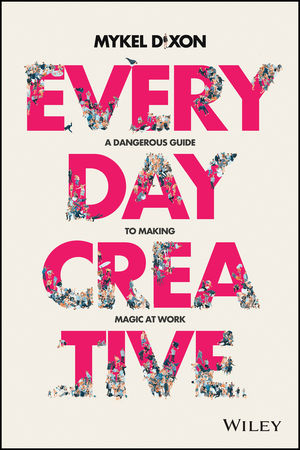Every Day Creative is aimed at people who work in large organisations or with groups of people. In it, Mykel Dixon sets out to convince the reader that, regardless of their circumstances and self-image, they can become creative. In addition, the book requires the reader to take certain specific actions. In that respect, the book is an activity manual.
It quickly becomes clear what Nixon means when he subtitled this book ‘A Dangerous Guide to Making Magic at Work’. He asks the reader to write down what changes they are seeking to make to themselves, what impact they expect to have on the world, and how they think they will be remembered after they are dead. This is not the only exercise Nixon demands, and for many readers it is unlikely to be the hardest.
Dixon quotes what many people have told him comes to mind when they first hear the word ‘creativity.’ The answers include endless possibility, joyful expression, letting go of control, and challenging the norm. The term was also associated with positive descriptors like fun, freedom, playfulness, curiosity, energy, and excitement.
Dixon writes that trying to define creativity is ‘like trying to hold smoke. It’s as elusive as it is essential.’ His goal and hope is that the reader, with the help of this book, will find practical ways to become more creative, and embrace personal creativity as essential. Readers are tasked to define what creativity means for themselves, why it is important and how best to use it.
Herein lies both the strength and weakness of this book. At one end of the scale, the reader may consider creativity is exemplified by writing a short letter to the editor or planting a few herbs in the backyard. At the opposite end, creativity might mean inventing something new, innovative and unique.
In fairness, the book aims to push the reader towards the upper end of this scale but any form of creativity is labelled successful, which means some readers can consider themselves ‘graduates’ of the book having achieved very little or nothing.
The activities and mindsets recommended in Everyday Creativity are based on the plausible assumption that erosion of creativity can be reversed. Dixon quotes the findings made famous by George Land, which showed just how highly creative five-year-old children are, and how their creativity is typically eroded over time, so when they reach adulthood, only about two percent of them can be described as highly creative.
The point is that our culture, our education system and our environment all tend to suppress creativity – but that it can be recovered.
Dixon’s goal and hope is that the reader, with the help of this book, will find practical ways to become more creative, and embrace personal creativity as essential.
That leaves the question as to whether a high level of creativity is essential for every worker, which is the underlying assumption in the book. However, it is just that – an assumption. It is arguable, after all, that many of us lead productive and happy lives with a modest level of creativity.
There is little doubt that this book could be of use to those who are willing to follow its instructions and exercises. At least, it is an interesting read with some useful insights into what creativity is, its many guises and manifestations, and how one can benefit from it.

Every Day Creative: A Dangerous Guide to Making Magic at Work
Mykel Dixon
Publisher: Wiley Books
ISBN: 9780730383734
Format: Paperback 248pp
RRP: $29.95
Publication Date: 1 July 20





